Alfa Romeo: Difference between revisions
I'm sure it's not sold in lots of places, no need to name any of them. |
→Top Gear: irrelevant to the topic |
||
| Line 242: | Line 242: | ||
*The Alfa Romeo challenge, in which the presenters 'prove' that the Alfa is the shortcut to petrolhead heaven, for £1000. Jeremy bought an Alfa 75 3.0 V6, in black + grey rust. Richard bought a ''very'' decrepit 1980's Spider, and James a 1990's GTV 2.0 Twinspark, thus representing all three generations of post-war Alfa Romeo. Challenges included: Racing at a track day (revealing the wheels of clay of each of the cars), making a photo calendar for sale in the presenter's local shops (with dismal sales results), and entering their cars in a Concourse competition. Highlights include Hammond's 'dead' Spider being towed by Clarkson's 'dying' 75, the clutch foibles of the GTV, and a cheesy sabotage of James May in time for the concourse competition. |
*The Alfa Romeo challenge, in which the presenters 'prove' that the Alfa is the shortcut to petrolhead heaven, for £1000. Jeremy bought an Alfa 75 3.0 V6, in black + grey rust. Richard bought a ''very'' decrepit 1980's Spider, and James a 1990's GTV 2.0 Twinspark, thus representing all three generations of post-war Alfa Romeo. Challenges included: Racing at a track day (revealing the wheels of clay of each of the cars), making a photo calendar for sale in the presenter's local shops (with dismal sales results), and entering their cars in a Concourse competition. Highlights include Hammond's 'dead' Spider being towed by Clarkson's 'dying' 75, the clutch foibles of the GTV, and a cheesy sabotage of James May in time for the concourse competition. |
||
*Alfa Romeo MiTo, described by Richard Hammond as 'One of the coolest cars you can buy for less than £15000...its beautiful, and best of all, its an Alfa!' |
*Alfa Romeo MiTo, described by Richard Hammond as 'One of the coolest cars you can buy for less than £15000...its beautiful, and best of all, its an Alfa!' |
||
Alfisti esteem Top Gear and Jeremy Clarkson for praising their cars, and making their passionate commitment to the marque better known. |
|||
====Other television shows==== |
====Other television shows==== |
||
Revision as of 21:35, 29 January 2010
| Alfa Romeo logo | |
| Company type | Private |
|---|---|
| Industry | Automotive |
| Predecessor | Società Anonima Italiana Darracq (SAID) |
| Founded | 24 June 1910 in Milan, Italy |
| Founder | Alexandre Darracq/Ugo Stella Nicola Romeo |
| Headquarters | , Italy[1] |
Area served | Worldwide |
Key people | Luca di Montezemolo (President) Harald J. Wester (CEO) |
| Products | Automobiles |
| Parent | Fiat Group Automobiles S.p.A. |
| Website | AlfaRomeo.com |
Alfa Romeo Automobiles S.p.A. is an Italian automaker founded on June 24, 1910 in Milan.[2] Alfa Romeo has been a part of the Fiat Group since 1986,[3] and since February 2007 a part of Fiat Group Automobiles S.p.A. The company was owned by Italian state holding company Istituto per la Ricostruzione Industriale between the end of 1932 to 1986. The company was originally known as A.L.F.A., which is an acronym for Anonima Lombarda Fabbrica Automobili (English: Lombard Automobile Factory, Public Company).
History
Foundation and early years
| Year | Cars | Industrial vehicles |
|---|---|---|
| 1934 | 699 | 0 |
| 1935 | 91 | 211 |
| 1936 | 20 | 671 |
| 1937 | 270 | 851 |
| 1938 | 542 | 729 |
| 1939 | 372 | 562 |

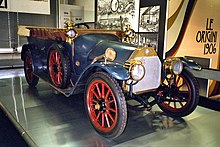

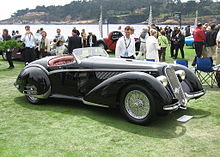




The company that became Alfa Romeo was founded as Società Anonima Italiana Darracq (SAID) in 1906 by the French automobile firm of Alexandre Darracq, with some Italian investors. One of them, Cavaliere Ugo Stella, an aristocrat from Milan, became chairman of the SAID in 1909.[5] The firm's initial location was in Naples, but even before the construction of the planned factory had started, Darracq decided late in 1906 that Milan would be a more suitable location and accordingly a tract of land was acquired in the Milan suburb of Portello, where a new factory of 6,700 square metres (8,000 sq yd) was erected. Late 1909, the Italian Darracq cars were selling slowly and Stella, with the other Italian co-investors, founded a new company named A.L.F.A. (Anonima Lombarda Fabbrica Automobili), initially still in partnership with Darracq. The first non-Darracq car produced by company was the 1910 24 HP, designed by Giuseppe Merosi, hired in 1909 for designing new cars more suitable to the Italian market. Merosi would go on to design a series of new A.L.F.A. cars, with more powerful engines (40-60 HP). A.L.F.A. also ventured into motor racing, drivers Franchini and Ronzoni competing in the 1911 Targa Florio with two 24 HP models. In 1914, an advanced Grand Prix car was designed and built, the GP1914 which featured a four cylinder, double overhead camshafts, four valves per cylinder and twin ignition.[6] However, the onset of World War I halted automobile production at A.L.F.A. for three years.
In August 1915 the company came under the direction of Neapolitan entrepreneur Nicola Romeo, who converted the factory to produce military hardware for the Italian and Allied war efforts. Munitions, aircraft engines and other components, compressors and generators based on the company's existing car engines were produced in a vastly enlarged factory during the war. When the war was over, Romeo invested his war profits in acquiring locomotive and railways carriage plants in Saronno (Costruzioni Meccaniche di Saronno), Rome (Officine Meccaniche di Roma) and Naples (Officine Ferroviarie Meridionali), which were added to his A.L.F.A. ownership. Car production had not been considered at first, but resumed in 1919 since parts for the completion of 105 cars were still lying at the A.L.F.A. factory since 1915.[5] In 1920, the name of the company was changed to Alfa Romeo with the Torpedo 20-30 HP becoming the first car to be badged as such.[7] Their first success came in 1920 when Giuseppe Campari won at Mugello and continued with second place in the Targa Florio driven by Enzo Ferrari. Giuseppe Merosi continued as head designer, and the company continued to produce solid road cars as well as successful race cars (including the 40-60 HP and the RL Targa Florio).
In 1923 Vittorio Jano was lured away from Fiat, partly thanks to the persuasion of a young Alfa racing driver named Enzo Ferrari, to replace Merosi as chief designer at Alfa Romeo. The first Alfa Romeo under Jano was the P2 Grand Prix car, which won Alfa Romeo the inaugural world championship for Grand Prix cars in 1925. For Alfa road cars Jano developed a series of small-to-medium-displacement 4, 6, and 8 cylinder inline power plants based on the P2 unit that established the classic architecture of Alfa engines, with light alloy construction, hemispherical combustion chambers, centrally-located plugs, two rows of overhead valves per cylinder bank and dual overhead cams. Jano's designs proved to be both reliable and powerful.
Enzo Ferrari proved to be a better team manager than driver, and when the factory team was privatised, it then became Scuderia Ferrari. When Ferrari left Alfa Romeo, he went on to build his own cars. Tazio Nuvolari often drove for Alfa, winning many races prior to World War II.
In 1928 Nicola Romeo left, with Alfa going broke after defense contracts ended, and in the end of 1932 Alfa Romeo was rescued by the government,[7] which then had effective control. Alfa became an instrument of Mussolini's Italy, a national emblem. During this period Alfa Romeo built bespoke vehicles for the wealthy, with the bodies normally built by Touring of Milan or Pinin Farina. This was the era that peaked with the legendary Alfa Romeo 2900B Type 35 racers.
The Alfa factory (converted during wartime to the production of Macchi C.202 Folgore engines) was bombed during World War II, and struggled to return to profitability after the war. The luxury vehicles were out. Smaller mass-produced vehicles began to be produced in Alfa's factories beginning with the 1954 model year, with the introduction of the Giulietta series of berline (saloons/sedans), coupes and open two-seaters. All three varieties shared what would become the classic Alfa Romeo overhead Twin Cam four cylinder engine, initially in 1300 cc form. This engine would eventually be enlarged to 2 liters (2000 cc) and would remain in production through 1995.
Post war
Once motorsports resumed after World War II, Alfa Romeo proved to be the car to beat in Grand Prix events. The introduction of the new formula (Formula One) for single-seat racing cars provided an ideal setting for Alfa Romeo's tipo 158 Alfetta, adapted from a pre-war voiturette, and Giuseppe Farina won the first Formula One World Championship in 1950 in the 158. Juan Manuel Fangio secured Alfa's second consecutive championship in 1951.
In 1952, Alfa-Romeo had experimented with its first front-wheel drive compact car named "Project 13-61".[8] It had the same transverse-mounted, forward-motor layout as the modern front-wheel drive automobiles. Alfa-Romeo made a second attempt toward the late 1950s based on Project 13-61. It was to be called Tipo 103. It even resembled the smaller version of its popular Alfa-Romeo Giulia. However, due to the financial difficulties in post-war Italy, the Tipo 103 never saw the production. Had Alfa-Romeo succeed in producing Tipo 103, it would precede the Mini as the first "modern" front-wheel drive compact car.
During the 1960s, Alfa concentrated on competition using production-based cars, including the GTA (standing for Gran Turismo Allegerita), an aluminium-bodied version of the Bertone-designed coupe with a powerful twin-plug engine. Among other victories, the GTA won the inaugural Sports Car Club of America's Trans-Am championship in 1966. In the 1970s, Alfa concentrated on prototype sports car racing with the Tipo 33, with early victories in 1971. Eventually the Tipo 33TT12 gained the World Championship for Makes for Alfa Romeo in 1975 and the Tipo 33SC12 won the World Championship for Sports Cars in 1977.
By the 1970s Alfa was again in financial trouble. The Italian government company Finmeccanica bowed out in 1986 as Fiat Group bought in, creating a new group, Alfa Lancia Industriale S.p.A.,[7] to manufacture Alfas and Lancias. Models produced subsequent to the 1990s combined Alfa's traditional virtues of avant-garde styling and sporting panache with the economic benefits of product rationalisation, and include a "GTA" version of the 147 hatchback, the Giugiaro-designed Brera, and a high-performance exotic called the 8C Competizione (named after one of Alfa's most successful prewar sports and racing cars, the 8C of the 1930s).
In 2005 Maserati was bought back from Ferrari and brought under Fiat's full control. The Fiat Group plans to create a sports and luxury division from Maserati and Alfa Romeo.[9] There is a planned strategic relationship between these two; engines, platforms and possibly dealers will be shared in some market areas.[10]
In the beginning of 2007, Fiat Auto S.p.A. was reorganized and four new automobile companies were created; Fiat Automobiles S.p.A., Alfa Romeo Automobiles S.p.A., Lancia Automobiles S.p.A. and Fiat Light Commercial Vehicles S.p.A. These companies are fully owned by Fiat Group Automobiles S.p.A.[11]
The history of the Alfa Romeo badge

In 1910 a draughtsman named Romano Cattaneo was given the job of coming up with a badge for a new Milan-based company, ALFA. It is generally accepted that the badge is based on the coat of arms of the House of Visconti and the red cross on a white background of Milan[citation needed]. In the early part of the 5th century AD a serpent that devoured humans was said to be at large in the area around Milan and terrifying the local populace. It was slain by Ottoni Visconti and this heroic deed was celebrated as part of the coat of arms[citation needed]. The red cross on a white back ground celebrates the deeds of Giovanni Da Rio, who is reputed to have been the first to climb the walls of Jerusalem and erect a cross there during the first crusade[citation needed]. The badge can be seen as a shield, reversed, above the great door of the Castello Sforzesco in Milan.
In 1918, after the company was purchased by Nicola Romeo, the badge was redesigned with the help of Giuseppe Merosi to include the emblem of the City of Milan and that of the Visconti family in a circular motif, bordered by a dark blue metallic ring containing the inscription "ALFA — ROMEO" and "MILANO" separated by two Savoy dynasty knots to honour the Kingdom of Italy.
After the victory of the P2 in the inaugural Automobile World Championship in 1925, Alfa added a laurel wreath around the logo.
In 1946 after the victory of the Italian Republic Savoy knots were replaced with two curvy lines.
The name "MILANO", the hyphen and the Savoy knots (lines) were eliminated when Alfa Romeo opened the factory at Pomigliano d'Arco, Naples in early 1970s.
Racing history

Alfa Romeo has always been involved with motor racing. In the 1920s and 30s Alfa Romeo scored wins at many of the most famous and prestigious races and motoring events such as Targa Florio, Mille Miglia and Le Mans. Great success continued with Formula One, Prototypes, Touring and Fast Touring. Private drivers also entered some rally competitions, with fine results. Alfa Romeo has competed both as a constructor and an engine supplier, via works entries Alfa Corse, Autodelta and private entries. Today Alfa Romeo is active in different Touring car series and the new Alfa Romeo 8C Competizione is planned to take part to Le Mans GT2 class in the near future.[12]
Carabinieri and Italian government
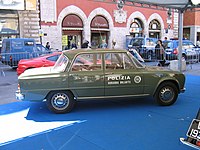
In the 1960s Alfa Romeo became famous for its small cars and models specifically designed for the Italian police — "Panthers" and Carabinieri; among them the glorious "Giulia Super" or the 2600 Sprint GT, which acquired the expressive nickname of "Inseguimento" dir. trl. "to chase or predate" (this car is wrongly supposed to be the one that the famous Roman police marshal and unrivalled driver Armandino Spadafora brought down on the Spanish Steps in 1960 while following some robbers — it was actually a black Ferrari 250 GT/E — this picture of Giulia,[13] one of the dozens about this legend, is taken from a movie and not at the Spanish Steps). The colours of the Alfa Romeos used by the Polizia were grey/blue with white stripes and writing, known as "Pantera" (Panther), enhancing the aggressive look of the Alfa (particularly the Giulia series), while the Carabinieri Alfas were dark blue with white roofs and red stripes, known as the "Gazzella" (Antelope) denoting the speed and agility of these "Pattuglie" (armed response patrol units). However, the term "Pantera" became used interchangeably and the image helped create a no-nonsense, determined and respected perception by the general public of the men that drove these cars, true to their history.
Since then, Alfas remain the chosen mount of the Carabinieri (renowned arm of the Italian Armed Forces seconded only partly for civilian Policing purposes), Polizia Autostradale (Highway Police) and the conventional police service (Polizia). Successively, the following Alfa Romeo Berlinas have found favour for Italian Police and Government employment:
- Alfetta
- Nuova Giulietta
- Alfa Romeo 75
- Alfa Romeo 164 (Official Vehicles)
- Alfa Romeo 155
- Alfa Romeo 156
- Alfa Romeo 166 (Official Vehicles)
- Alfa Romeo 159
Since 1960s, the Italian Prime Minister has used Alfa Romeos (and lately the new Maserati Quattroporte) as preferred government limousines. The 164, and 166 have found particular employment in the last two decades.
Technological development
The following is a list of some technology introduced quite early by Alfa Romeo, along with the models that introduced each one:
- DOHC Engine (1914 Grand Prix car, 1920s 6C road cars)
- Mechanical Variable Valve Timing (Duetto/Spider)
- All-wheel disc brakes (105 series Giulia)
- Plastic radiator header tank (105 series Giulia)
- Lowest Drag Coefficient (Cd) in class (105 series Giulia)
- 50:50 weight distribution (Alfetta 2000 & GTV)
- Standard Fit Alloy wheels (Alfetta 2000 & GTV)
- Transaxle (Alfetta 2000 & GTV)
- Electronic Variable Valve Timing (Alfetta)
- Complete CAD design process (Alfa Romeo 164)
- Robotised/Paddle control transmission (156 Selespeed)
- Common rail diesel engine (156)[14]
- Multiair -an electro-hydraulic variable valve actuation technology (MiTo)
Body design
Over the life of the marque, many famous automotive design houses in Italy have accepted commissions to produce concepts and production vehicle shapes for Alfa Romeo. A selection of these include the following
- Bertone
- Giorgetto Giugiaro / Italdesign
- Pininfarina
- Zagato
- Centro Stile Alfa Romeo
The last mentioned, the Centro Stile, has rapidly gained international credibility with its work. The 8C Competizione super-coupé, and the MiTo hatchback are the result of their work.
Construction techniques used by Alfa Romeo have become imitated by other car makers, and in this way Alfa Romeo body design has often been very influential. The following is a list of innovations, and where appropriate, examples of imitation by other car manufacturers:
- 1950s : Monocoque body design in the Giulia : While not an imitation per se, this construction technique became extremely widespread, and remains so to the present day.
- 1960s : Aerodynamics : The 116-serie Giulia boasted a very low Cd. Toyota in particular sought to produce a similarly shaped series of vehicles at this time.
- 1970s : Fairing of bumpers : In order to meet American crash standards, Alfa formulated design styling techniques to incorporate bumpers into the overall bodywork design of vehicles so as to not ruin their lines. The culmination of this design technique was 1980s Alfa Romeo 75. The process was widely copied, particularly in Germany and Japan.
- 1980s : The Alfa 164 : The design process and influence of this car is almost completely out of all proportion to previous Alfas. The 164 introduced complete CAD/CAM in the manufacturing cycle, with very little directly made my hand in the vehicle. In addition, the 164's styling influence continues into the present day line of modern Alfa's. Most manufacturers incorporated design ideas first expressed in the 164 into their own designs, including greater reliance on on-board computers.
- 1990s : The pseudo-coupe : The Alfa 156 and 147, while 4-door vehicles, represented themselves as two-doors with prominent front door handles, and less visible rear door-handle flaps. Honda has used this design style in the latest Civic hatchback, and a somewhat similar idea is also seen in the most recent Mazda RX-8 four-seat coupe.
- 2000s : The Brera and 159 : These vehicles design, by Giorgetto Guigaro, have proven influential as regards sedan and coupe styling, demonstrating that concept vehicles are often immediately translatable into road car form, providing that initial design takes place using CAD systems.
Alfa Romeo models have also served as the inspiration and basis of some very interesting and often beautiful concept cars. Here follows a short list of concept cars, and their impacts on car design:
1950s : The B.A.T. Cars The Berlina Aerodinamica Tecnica prototype cars were designed by Bertone as an exercise in determining whether streamlining and wind-tunnel driven designs would result in high performance on a standard chassis, and whether the resulting vehicles would be palatable to public. Alfa 1900 Sprint were the basis of the B.A.T. 5, 7 and 9.[15] The later B.A.T. 11 was based on the 8C Competizione.
1960s and 1970s : Descendants of the Tipo 33 The Tipo 33 racing car, with its high-revving 2000c V-8 engine became the basis for a number of different concept cars during 1960s and 1970s, two of which utlimately resulted in production vehicles. Most made their appearances at the Auto Salon Genève. Here is a brief list:
- Gandini/Bertone Carabo (1968) - Marcello Gandini expressed ideas that would come to fruition in the Lamborghini Countach.
- Tipo 33.2 (1969)- Designed by Pininfarina, this car ultimately resulted in the 33 Stradale road car
- Gandini/Bertone Montreal Concept (1967) - making its appearance at the 1967 Montreal Expo, this Giulia-based concept resulted in the production Alfa Romeo Montreal road car with a variant of the Tipo 33 V8 engine.
- Bertone/Guigaro Navajo (1976)- A fully fibreglassed vehicle, and in some ways the epitome of Guigaro's 'Origami' style of flat planes.
1980s - today : Modern Ideas In general, concept cars for Alfa Romeo have generally become production vehicles, after some modification to make them suitable for manufacture, and to provide driver and passenger safety. The Zagato SZ, GTV and Spider (descended from the Proteo), Brera and 159 are all good examples of Alfa Romeo's stylistic commitment in this direction.
The Future Alfa Romeo concept cars have mostly emphasized performance in combination with historical tradition. The Nuvola Concept, and the independently designed Diva Concept cars have demonstrated that this ethos is the centre of Alfa conceptualisation. The Centro Stile website also gives designers very good direction in terms of the combination of line and form Alfa prefers to see in the design process of its car's bodywork.
Sociology
In Italian the owner of an Alfa Romeo is an "Alfista", and a group of them are "Alfisti". Alfa Romeo is sometimes worshipped by its owners, and many models have become cultural symbols. There are many thriving Alfa Romeo owners clubs and Alfa Romeo Model Registers.
Alfa Romeo motorcars are recognised by all Motor enthusiasts as being the first "supercar", with the term being coined in the 1920s by a British journalist to describe an Alfa Romeo. Some notable owners include Beppe Carletti (Musician, Retailer - 2000 Spider), Jeremy Christian (Classic Track Driver, Writer - GTV), Jeremy Clarkson (Motoring Journalist - GTV6), Alex Hucksley (Actor, Stock Broker - Duetto), Roger Moore (Actor - GTV6) and Michael Schumacher (F1 Driver - Giulietta Super).
The Hosting team of the popular British motoring interest show Top Gear often state that a car enthusiast must have owned an Alfa Romeo at some point before they can be considered a true petrolhead (meaning an extreme car enthusiast).
Movies and television
Alfa Romeo's have often found favour during productions where an attractive car is a necessary, a natural result of the artistic beauty associated with the marque, and the romantic connatations associated with Italy.
Post-war Italian cinema is replete with Alfa Romeo's, often as a result of police dramas were Alfa's are official vehicles (and remain so to this day), as well as contemporary comedies and romances, where Alfa's are taxis, and 'playboy' character vehicles.
In American cinema and television, where characters find themselves in Italy, Alfa Romeos, particularly the Spider (due to The Graduate, see below), dominate. Other models have featured, though sporadically.
Most on-screen appearances of Alfa Romeo's have tended towards popularly considered 'beautiful' models (such as the Spider), and 'handsome' types (such as the 116 Giulia, and Alfetta Sedan).
The Graduate

Certainly the most famous appearance and presence on screen of any Alfa must be the 1967's hit film The Graduate, starring Dustin Hoffman, Katharine Ross and Anne Bancroft. It gave worldwide celebrity to the "Spider" (best known by the Italian nickname of "Duetto", or as "Osso di Seppia," meaning "cuttlefish bone," or Round-tail), and also for its elegant and attractive form.[16] The Spider depicted on screen had its engine note accurately recorded, and electrical foibles (the non-functional fuel gauge) reproduced. On the strength of the Spider's appeal, Alfa Romeo continued sales of the Spider into the 1990s, and a special edition named the Alfa Graduate was available in the United States in the 1980s.
The entire set of scenes featuring the Spider in the Graduate were replicated in satire by Mike Myers in his comedy, Wayne's World 2. The Spider here cuts out Simon & Garfunkel's "Mrs. Robinson" when passing under a bridge (implying music being played on a radio), but still has a non-functional fuel gauge - causing it to ultimately grind to halt (fortunately at the correct church!)
The Spider was designed by Pininfarina; derived from several design studies dating back to the late 1950s, the Spider is believed to be the last design on which Battista Farina personally worked.
The Italian Job
Alfa Romeo Giulia 'Panthers' appear as Polizia cars in the 1969 movie The Italian Job. During the chase in Turin each suffers an unpleasant, yet humorous demise. Memorable 'deaths' include breaking down on top the roof of a gently sloping building dome, and being washed away by the flow of water from a weir while chasing a Mini.
James Bond
Alfas have featured on-screen in three James Bond films.
Blue Polizia Alfettas are seen in For Your Eyes Only, haring up a snowy mountainside in one shot.
One of the most prominent roles was when James Bond (Roger Moore) stole and then drove a graphite GTV6 in 1983's Octopussy. In the scene it is pursued by two Bavarian BMW 5-series police cars.
A pair of black Alfa Romeo 159 Ti cars appeared in the opening scenes of the 2008 James Bond film Quantum of Solace. They featured in the car chase with James Bond's Aston Martin DBS V12 around Lake Garda, Italy. Noteworthy attention was paid to the auditory qualities of the Alfa's, which have the characteristic 'Big V-6' sound on-screen. The same film also features a Carabineri Alfa 156. Rene Mathis also has an Alfa, a white 2600 GT coupe.
Other films
- Giulietta Masina in Fellini's Juliet of the Spirits is courted by a "Romeo" in a Giulietta (Spider), a double play on words.
- Edward Fox's character, the titular Jackal, in 1973's The Day of the Jackal drives a white Giulietta Spider. He repaints the car blue in a forest clearing to avoid police, then crashes the car.
- Michael Corleone (Al Pacino) in The Godfather drove a black Alfa Romeo 6C while in exile in Sicily. This was actually the car that was booby-trapped and explodes with Apollonia, his Sicilian wife, in it toward the end of the movie. María Corleone drove a red spider.
- John Malkovich, as Tom Ripley, in Ripley's Game, drives a red Alfa Romeo 156 Sportwagon.
- In 2009s The International, starring Clive Owen, has a black four-wheel-drive Alfa Romeo 164 in a pivotal scene.
- In The Omen remake In the Italian scenes Robert Thorn drives an Alfa Romeo 164.
- In " The Talented Mr. Ripley", Phillip Seymour Hoffmann is seen Driving an Alfa Romeo Giulietta.
- In Gran Torino, during the credits an Alfa Romeo 164 drives by on Lake Shore Dr.
- In Ferris Bueller's Day Off, after Ferris convinces Cameron to come and pick him up for a day of fun, Cameron is pictured in a 1979 Alfetta GT .
- In Looney Tunes: Back In Action, Jenna Elfman's character is seen driving a 1988 Alfa Romeo Spider
- In Antonioni's "La Notte" a small Alfa is prominently featured as the protagonist's car
Aside from this, Alfas on screen are widespread in numerous Italian local productions.
Television
Top Gear
In recent times, the BBC Series 'Top Gear' has had the strongest effect on the popular conception of the Alfa Romeo. Presenters Jeremy Clarkson, Richard Hammond and James May insist that no-one can call themselves a true petrolhead until they have owned one. Numerous Alfas have had screentime devoted to them over the course of the TV program's run so far. Highlights include:
- Alfa Romeo GTV 3.0 V6 24v tested by Jeremy Clarkson
- Alfa Romeo 147 GTA, proved to be the 'hottest hot hatch ever'
- Alfa Romeo 166 3.2 (2nd Series, styling refit), which Jeremy Clarkson describes as being 'A black cocktail dress - at a Schloss - in Austria'
- Alfa Romeo 159, which James May uses to race against an extreme athlete crossing the river Humber, north-east Lincolnshire
- Alfa Romeo 8c Competizione, reviewed by Jeremy Clarkson, who considers it gorgeous and a work of Art.
- The Alfa Romeo challenge, in which the presenters 'prove' that the Alfa is the shortcut to petrolhead heaven, for £1000. Jeremy bought an Alfa 75 3.0 V6, in black + grey rust. Richard bought a very decrepit 1980's Spider, and James a 1990's GTV 2.0 Twinspark, thus representing all three generations of post-war Alfa Romeo. Challenges included: Racing at a track day (revealing the wheels of clay of each of the cars), making a photo calendar for sale in the presenter's local shops (with dismal sales results), and entering their cars in a Concourse competition. Highlights include Hammond's 'dead' Spider being towed by Clarkson's 'dying' 75, the clutch foibles of the GTV, and a cheesy sabotage of James May in time for the concourse competition.
- Alfa Romeo MiTo, described by Richard Hammond as 'One of the coolest cars you can buy for less than £15000...its beautiful, and best of all, its an Alfa!'
Other television shows
- In the television crime film series Ein Fall für Zwei ("a case for two", over 250 episodes made so far), the leading actor Claus Theo Gärtner, who plays the role of the private detective Josef Matula, has always been driving Alfa Romeo, starting from Giulia Super to the latest Alfa Romeo models.
- Alfa Romeo had also a "role" in the Austrian detective series Kommissar Rex (Inspector Rex). At the beginning, Tobias Moretti drove a 155 and later Gedeon Burkhard drove a 166.
- A "Giulietta Red" Alfa Romeo Mito appeared, in the popular soap opera, Coronation Street being owned by on-screen Businessman Luke Strong.
Literature
In the first printing of Dan Brown's novel Angels & Demons, the members of the Swiss Guard all drive Alfa Romeo sedans (albeit inaccurately referred to as 'Alpha Romeos' throughout the book).[17]
Production
| Year | Cars |
|---|---|
| 1998 | 197,680 |
| 1999 | 208,336 |
| 2000 | 206,836 |
| 2001 | 213,638 |
| 2002 | 187,437 |
| 2003 | 182,469 |
| 2004 | 162,179 |
| 2005 | 130,815 |
| 2006 | 157,794 |
| 2007 | 151,898 |
| 2008 | 103,097 |
Until the 1980s, Alfa Romeos, except for the Alfasud, were rear-wheel-drive.
According to the current Fiat CEO Sergio Marchionne in order to reap economies of scale, all new Alfa Romeo models will be made from the same basic platform (i.e., frame). Even Maserati will share components with some Alfas.[19]

Cloverleaf, or Quadrifoglio, badges denote high-end in comfort and engine size variants of Alfa Romeo cars, but previously denoted Alfa Romeo racing cars in the pre-Second-World-War era. The image first appeared in 1923 when Ugo Sivocci presented one prior to the start of the 14th Targa Florio as a good luck token to the team. This became the symbol of competition Alfas, denoting higher performance. Some modern Alfas wear a cloverleaf badge which is typically a green four leaf clover on a white background (Quadrifoglio Verde), but variants of blue on white have been recently observed as well.
The Alfettas of the early 1980s had models available sold as the "Silver Leaf" and "Gold Leaf" (Quadrifoglio Oro). These models were the top of the range. Badging was the Alfa Cloverleaf in either gold or silver to denote the specification level. The Gold Leaf model was also sold as the "159i" in some markets, the name in homage to the original 159.
The trim levels (option packages) offered today on the various nameplates (model lines) include the lusso ("luxury"), turismo ("touring"), and the GTA (gran tourismo alleggerita) ("light-weight grand tourer"). The GTA package is offered in the 147 and 156 and includes a V-6 engine. In the past, Alfa Romeo offered a Sprint trim level.
During the 1990s, Alfa Romeo moved car production to other districts in Italy. The Pomigliano d’Arco plant produced the 155, followed by the 145 and the 146, while Arese manufactured the 164 and new Spider and GTV. The 156 was launched in 1997, and became quite successful for Alfa Romeo; in 1998 it was voted “Car of the Year”. The same year a new flagship, the 166 (assembled in Rivalta, near Turin) was launched. At the beginning of the third millennium, the 147 was released, which won the prestigious title of “Car of the Year 2001”. In 2003 the Arese factory was closed.
The Arese factory today hosts almost nothing and is nearly abandoned. What remains are some offices and the great Alfa Romeo Historical Museum, a must-see for Alfa Romeo fans.
Right-hand drive production post-1960
In the 60s, the main Alfa Romeo seat was moved from inside Milan to a very large and nearby area extending over the municipalities of Arese, Lainate and Garbagnate Milanese. However, since then the Alfa seat is known to be in Arese, since the offices and the main entrance of the area are there.
In the late 1960s, a number of European automobile manufacturers established facilities in South Africa to assemble right hand drive vehicles. Fiat and other Italian manufacturers established factories along with these other manufacturers, Alfa-Romeos were assembled in Brits, outside of Pretoria in the Transvaal Province of South Africa. With the imposition of sanctions by western powers in the 1970s and 1980s, South Africa became self sufficient, and in car production came to rely more and more on the products from local factories. This led to a remarkable set of circumstances where between 1972 and 1989, South Africa had the greatest number of Alfa Romeos on the road outside of Italy.
| Assembly plants by model[20] | |||
|---|---|---|---|
| Plant | Owner | Location | Model(s) |
| Stabilimento Mirafiori | Fiat Group Automobiles S.p.A. | Turin | MiTo |
| Giambattista Vico | Fiat Group Automobiles S.p.A. | Pomigliano d'Arco, Naples | 147, 159, 159 Sportwagon, GT |
| San Giorgio Canavese | Pininfarina S.p.A. | San Giorgio Canavese, Turin | Brera, Spider |
| Modena | Maserati S.p.A. | Modena | 8C Competizione, 8C Spider |
Return to the United States
In 1995 Alfa Romeo ceased exporting cars to the United States, the last model to be sold being the 164. Rumors began of their return, however as the FAQ on Alfa's English website had said "The long-awaited return of Alfa Romeo to the United States market should take place by 2007, with a range of new models."
Alfa Romeo's return to United States was confirmed on 5 May 2006 by Fiat CEO Sergio Marchionne. Alfa Romeo resumed sales in the United States with the 8C Competizione in October 2008.[21] In late 2009, Alfa Romeo will release the 159, Brera, and Spider after they receive a mid-life styling and technical refreshening. It is anticipated that a year or two later will see the introduction of the Kamal SUV, 169, and possibly the B-segment Mi.To (as a competitor for the MINI Cooper). As with the 8C Competizione, Alfa Romeos will be initially sold at Maserati dealers throughout United States.[22] Alfa Romeo and Chrysler are currently in discussions, with Alfa Romeo possibly using Chrysler manufacturing plants that have been shut down due to unneeded product.[23]
Now when parent company Fiat has 20% share of Chrysler the Alfa Romeo return will probably start with Alfa Romeo MiTo.[24] The Wall Street Journal reported that on Nov. 4 2009 Chrysler would announce that it is dropping several models of Dodge and Jeep while phasing in Alfa Romeo and Fiat 500 models.[25] Alfa Romeo cars will be sold in the USA starting in 2011.[26]
Automotive
Current models
Alfa Romeo MiTo

The MiTo is a three door sporty supermini officially introduced on 19 June 2008 in Castello Sforzesco in Milan, the international introduction was at British Motor Show in 2008.
Alfa Romeo 147

The 147 is small family car produced by Italian automaker Alfa Romeo since 2000. It is based on the running gear of the larger 156 saloon, which was in production from 1997 to 2005. The most powerful GTA version uses the traditional name from the Alfa Romeo GTA. It will be replaced with Giulietta in 2010.
Alfa Romeo 159
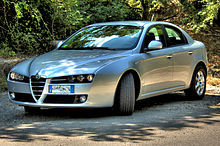
Current mid-size saloon, introduced in production form at the 2005 Geneva Motor Show. The 159 is available with four different petrol engines and three diesels. 159 Sportwagon is an estate version of this car. Was launched in 2005 to replace the 156.
Alfa Romeo GT

Front-wheel drive, Bertone designed, coupe'. The GT was introduced in 2004 and is based on the 156 sedan, which ceased production the following year. Engine options include three petrol versions (1.8L, 2.0L, 3.2L V6), the 3.2L V6 has been discontinued in some countries, but is still available in others and one turbo-charged diesel (1.9L) version. Interior is based heavily on the 147.
Alfa Romeo Brera

The car is a 2+2 coupe designed by Giorgetto Giugiaro and manufactured by Pininfarina. It was originally introduced as a concept car at the 2002 Geneva Motor Show, and was launched in 2005 as successor to the decade-old GTV. The production version maintained the exterior appearance almost exactly but on a smaller scale.
Alfa Romeo Spider
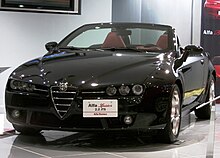
A roadster variant of Brera coupe was introduced at the 2006 Geneva Motor Show. The car replaced the Spider 916 model, introduced in 1995. Pininfarina assembles this car alongside the Brera in San Giorgio Canavese, Italy.
Alfa Romeo 8C Spider

At the 2005 Pebble Beach Concours d'Elegance published roadster version of 8C Competizione sports car. Production started from 2009.
Future models
- Alfa Romeo Giulietta (Expected-2010)
- Alfa Romeo Giulia (Expected-2011)
- Alfa Romeo 169 (Expected-2011)
- C Crossover (Expected-2010)
Historic models
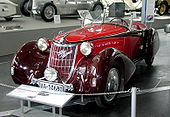
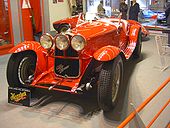
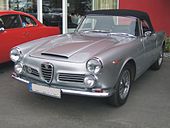
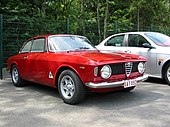
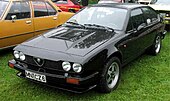
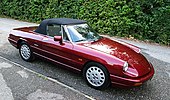
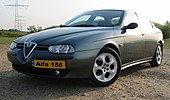
| Road cars | Racing cars | |
|---|---|---|
| 1910 |
1910-1920 24 HP |
1911 15 HP Corsa |
| 1920 |
1921-1922 20-30 HP |
1922 RL Super Sport |
| 1930 |
1931-1934 8C 2300 |
1931 Tipo A |
| 1940 |
|
1948 6C 2500 Competizione |
| 1950 |
1950-1958 1900 |
1951 159 |
| 1960 |
1962-1968 2600 |
1960 Giulietta SZ |
| 1970 |
1970-1977 Montreal |
|
| 1980 |
1983-1994 33 |
|
| 1990 |
1992-1998 155 |
1993 155 V6 TI |
Concepts
Design has always played a large role in the history of Alfa Romeo. There have been many Alfa Romeo concept cars, often made by famous design houses and designers. The BAT series of concepts from the 1950s was a joint collaboration project with the Italian design house Bertone. Other famous Italian coachbuilders and design houses like Pininfarina, Bertone, Zagato and ItalDesign-Giugiaro have also played a great role in Alfa Romeo's history, and even today some of models are designed and constructed by these great names.
Other production
Although Alfa Romeo is best known as automobile manufacturer it has produced also commercial vehicles, railway locomotives,[5] tractors, buses, trams, compressors, generators,cookers, marine and aircraft engines.
Aircraft engines
An Alfa engine was first used on an aircraft in 1910 on the Santoni-Franchini biplane.[27] In 1932 Alfa Romeo built its first real aircraft engine the D2 (240 bhp), which was fitted to Caproni 101 D2. In the 1930s when Alfa Romeo engines were used for aircraft on a larger scale; the Savoia Marchetti SM.74, Savoia-Marchetti SM.75, Savoia-Marchetti SM.79, Savoia Marchetti SM.81 and Cant Z506B Airone all used Alfa Romeo manufactured engines.[28] In 1931, a competition was arranged where Tazio Nuvolari drove his Alfa Romeo 8C 3000 Monza against a Caproni Ca.100 airplane.[29] Alfa Romeo built various aircraft engines during World War II; the best known was the RA.1000 RC 41-I Monsone, a licensed version of the Daimler-Benz DB 601. This engine made it possible to build efficient fighter aircraft like the Macchi C.202 Folgore for the Italian army. After World War II Alfa Romeo produced engines for Fiat, Aerfer and Ambrosini. In the 1960s Alfa Romeo mainly focused upgrading and maintaining Curtiss-Wright, Pratt & Whitney, Rolls-Royce and General Electric aircraft engines. Alfa Romeo built also Italy's first turbine engine, installed to the Beechcraft King Air. Alfa Romeo's Avio division was sold to Aeritalia in 1988,[30] from 1996 it was part of Fiat Avio.[31] Alfa Avio was also part of developing team to the new T700-T6E1 engine to the NHI NH90 helicopter.[32]
Trucks, light commercial vehicles
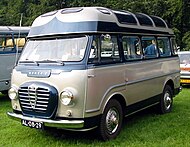
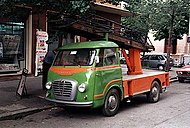
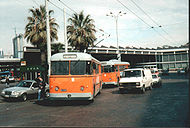
In 1930 Alfa Romeo presented a light truck in addition to heavy LCVs based to Büssing constructions.[33] In the Second World War Alfa Romeo also built trucks for the Italian army ("35 tons anywhere") and later also for the German Wehrmacht. After the war, commercial motor vehicle production was resumed. In co-operation with FIAT and Saviem starting from the 60s different light truck models were developed. The production of heavy LCVs was terminated in 1967. In Brazil the heavy trucks were built still few years by Alfa Romeo subsidiary Fábrica Nacional de Motores under the name FNM. Last Alfa Romeo vans were Alfa Romeo AR6 and AR8, which were rebadged versions of Iveco Daily and Fiat Ducato. The company also produced trolleybuses for many systems in Italy, Latin America,[34] Sweden,[35] Greece,[36] Germany, Turkey and South Africa. Later, Alfa Romeo concentrated only on passenger car manufacturing.
LCVs
- Romeo (1954-1958)
- Romeo 2 (until 1966)
- Romeo 3 (1966)
- A11/F11
- A12/F12 (until 1983)
- AR8 (based on first generation Iveco Daily)
- AR6 (based on first generation Fiat Ducato)
Trucks
- Alfa Romeo 430 (1942-1950)[37]
- Alfa Romeo 500
- Alfa Romeo 800 (1940-1943)[37]
- Alfa Romeo 900
- Alfa Romeo 950
- Alfa Romeo Mille (Alfa Romeo 1000)
- Alfa Romeo A19n (Saviem license)
Buses
- Alfa Romeo 140 A.
- Alfa Romeo 900 A.
- Alfa Romeo 950.
- Alfa Romeo Mille (Alfa Romeo 1000).
Trolleybuses
- Alfa Romeo 110AF (1938)
- Alfa Romeo 140AF (1949)
- Alfa Romeo 900
- Alfa Romeo Mille (Alfa Romeo 1000)
Alfa Romeo sponsorships

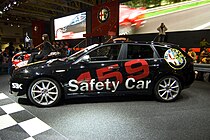
Yachting
In 2002 the first Alfa Romeo super maxi yacht was launched by Neville Crichton, named Alfa Romeo I. She has been first to finish in at least 74 races including the 2002 Sydney—Hobart Race.[38] He commissioned a new state-of-the-art super maxi in 2005, Alfa Romeo II, which measures 30 metres (98 ft) LOA. Alfa Romeo II set a new elapsed-time record for monohulls in the 2009 Transpac race, of 5 days, 14 hours, 36 minutes, 20 seconds[39] (Los Angeles to Honolulu). She has been first to finish in at least 140 races. In mid-2008, he launched Alfa Romeo III, for competitive fleet racing under the IRC rule. Alfa Romeo III measures 21.4 metres (70 ft) LOA and features interior design styled after the Alfa Romeo 8C Competizione.[40]
Motorcycle sports
Alfa Romeo is also sponsoring SBK Superbike World Championship and Ducati Corse since 2007. The Alfa Romeo MiTo 3-door sporty supermini has been used since 2009 as safety car in Superbike World Championship events.
Other events
Alfa Romeo has been sponsoring Goodwood Festival of Speed for many years and will be one of featured brands next year (2010) when Alfa Romeo will celebrate its 100th anniversary.[41][42] Alfa Romeo is also sponsoring the Mille Miglia rally.[43]
See also
References
- ^ "2008 Half-yearly Financial Report/Alfa Romeo Automobiles S.p.A. Torino, Page 76" (PDF). 2008. Retrieved 2009-06-18.
- ^ "Alfa Romeo Celebrates 90 Years Of Success". autoweb.com. 2000. Retrieved 2009-01-09.
- ^ "Alfa Romeo". fundinguniverse.com. Retrieved 2009-01-09.
- ^ Patrick Italiano. "STORY OF THE ALFA ROMEO FACTORY AND PLANTS:PART 2 ALFA ROMEO UNDER A KHAKI UNIFORM" (PDF). enzociliberto.it/aisastoryauto. Archived from the original (PDF) on 2007-09-29. Retrieved 2009-10-19.
- ^ a b c "P. Italiano: 'Story of the Alfa Romeo factory and plants : part 1 the early Portello'" (PDF). Retrieved 2009-10-19.
- ^ Fusi, Luigi, Le Alfa di Romeo e Merosi, Edizione Dimensione S, Milan, 1985
- ^ a b c "Alfa Romeo History/The Company". alfaromeo.com. Retrieved 2007-05-02.
- ^ Tim Rauen. "Tim's Alfa Romeo Page - Alfasud". Alfasud.alfisti.net. Retrieved 2009-11-29.
- ^ "News 12.07.2005". italiaspeed.com. Retrieved 2007-05-02.
- ^ "Press release 1 April 2005". fiatgroup.com. Retrieved 2007-05-02.
- ^ "Press release 23/01/2007". fiatautopress.com. Retrieved 2007-05-02.
- ^ "Racing news 20.12.2006". italiaspeed.com. Retrieved 2007-04-25.
- ^ http://web.archive.org/web/20080307030626/http://www.alfaclubdc.com/suprflm3.jpg
- ^ "New Powertrain Technologies Conference". autonews.com. Retrieved 2008-04-08.
- ^ "1954 Alfa Romeo B.A.T. 7". conceptcarz.com/vehicle. Retrieved 2009-06-11.
- ^ http://hem.passagen.se/veloce/wpe28.jpg
- ^ "Orgy of Misspellings in Blockbuster Dan Brown Novel". jalfredproofreader.blogspot.com. Retrieved 2009-09-22.
- ^ "Alfa Romeo production between 1998-2007". oica.net. Retrieved 2008-12-27.
- ^ "Saving Fiat", The Economist, 3 December 2005, p. 64, vol. 377.
- ^ "Fiat Group Automobiles" (PDF). fiatgroup.com/it-it. Retrieved 2009-05-20.
- ^ "Welcome Back! Alfa Romeo 8C Competizione Launches in America". wot.motortrend.com. Retrieved 2008-11-24.
- ^ "Latest News 07/13/06". autoweek.com. Retrieved 2007-04-25.
- ^ "Latest News 05/27/08". Autoblog.com. Retrieved 2008-05-27.
- ^ "Italiaspeed news of Chrysler". italiaspeed.com/2009/cars/industry. Retrieved 2009-06-18.
- ^ "Fiat Models to Drive Chrysler New Lineup Will See Return of Alfa Romeo, End of Many Chryslers, Dodges and Jeeps". online.wsj.com. Retrieved 2009-10-27.
- ^ www.rpmgo.com/alfa-romeos-us-return-delayed-until-2011
- ^ Borgeson, Griffith. The Alfa Romeo Tradition. ISBN 0-85429-875-4.
- ^ "Alfa Romeo AEREI Collezione Modelli di Marco Rigoni Settembre 2005" (PDF). aerei-italiani.net. Retrieved 2007-04-25.
- ^ "La storia di due "duelli" inconsueti avvenuti a 50 anni di distanza l'uno dall'altro". digilander.libero.it. Retrieved 2007-04-25. Template:It icon
- ^ "Retrospective: Automobiles and aeroplanes: Alfa Romeo". channel4.com. Retrieved 2007-08-20.
- ^ "FiatAvio acquires Alfa Romeo Avio". madeinfiat.com. Retrieved 2007-08-20.
- ^ "Alfa Romeo Avio (Italy), Buyer's Guide Engine Manufacturers". janes.com. Retrieved 2008-12-23.
- ^ "Alfa Romeo trolleybusses" (PDF). newedgeconcept.com via web.archive.org. Archived from the original (PDF) on 2007-06-05. Retrieved 2009-07-16.
- ^ "Latin American Trolleybus Installations". tramz.com. Retrieved 2009-06-17.
- ^ "Stockholm Trådbuss 20/1-1941 -- 31/8-1964" (PDF). sparvagssallskapet.se. Retrieved 2009-06-17.
- ^ "Europe - Soviet Union & Exported ZIU Trolleybuses". sptc.spb.ru. Retrieved 2009-06-17.
- ^ a b "Le modélisme militaire italien à toutes les échelles". italie1935-45. Retrieved 2008-01-09. Template:Fr icon
- ^ "Alfa Romeo Maxi Yacht". www.alfaromeo.com.au. Retrieved 2008-05-29.
- ^ Fitzpatrick, Lynn (2009-07-11). "Alfa Romeo Smashes Transpac Record by a Day". Finish reports (in American English and portion haw). Transpacific Yacht Club. Retrieved 2009-07-16.
{{cite web}}: CS1 maint: unrecognized language (link) Alfa Romeo II is a monohull and set a new monohull elapsed time record. She came within about five hours of breaking the multihull elapsed time record 5d, 9h, 18m set in 1997 by Bruno Peyron with his Commodore Explorer. - ^ Unattributed. "Alfa Romeo 3 Images". Alfa Romeo Maxi Yacht. Alfa Romeo Yacht Racing Team. Retrieved 2009-07-09.
- ^ "21.11.2009 Centenary celebrating Alfa Romeo to take centre stage at Festival Of Speed". www.italiaspeed.com/2009/cars/alfa_romeo. Retrieved 2009-11-21.
- ^ "Goodwood Festival of Speed - Sponsors". goodwood.co.uk. Retrieved 2009-07-09.
- ^ "sponsors". 1000miglia.eu. Retrieved 2009-07-09.
Further reading
- Borgeson, Griffith (1990). The Alfa Romeo Tradition. Haynes (Foulis) Publishing Group Ltd. Somerset, UK. ISBN 0854298754.
- Braden, Pat (1994). Alfa Romeo Owner's Bible Cambridge: Bentley Publishers. ISBN 0837607078.
- Stefano d' Amico and Maurizio Tabuchi (2004). Alfa Romeo Production Cars. Giorgio NADA Editore. ISBN 8879113224.
- Hull and Slater (1982). Alfa Romeo: a History. Transport Bookman Publications. ISBN 0851840418.
- Venables, David (2000). First among Champions. Osceola: Motorbooks International. ISBN 1859606318.
- Owen, David. Great Marques, Alfa Romeo. London: Octopus Books, 1985. ISBN 0706422198
- Owen, David. Alfa Romeo: Always with Passion. Haynes Publications, 1999. ISBN 1859606288
- Moore, Simon (1987). Immortal 2.9. Parkside Pubns. ISBN 9780961726607.
- Mcdonough, E., & Collins, P. (2005). Alfa Romeo Tipo 33. Veloce Publishing. ISBN 1904788718
- Tipler, John. Alfa Romeo Spider, The complete history. Crowood Press (UK), 1998. ISBN 1861261225
- Tipler, John. Alfa Romeo Giulia Coupe Gt & Gta. Veloce Publishing, 2003. ISBN 1903706475
